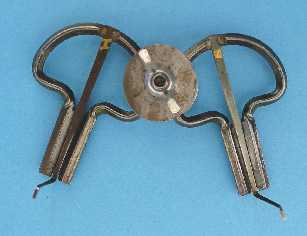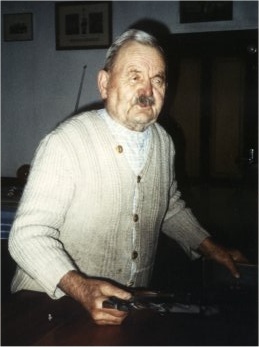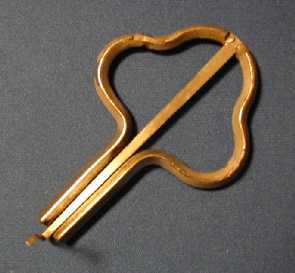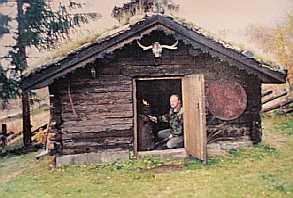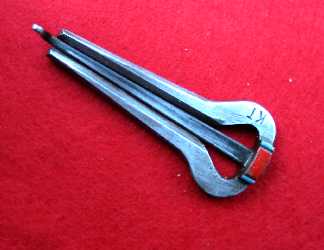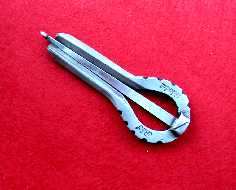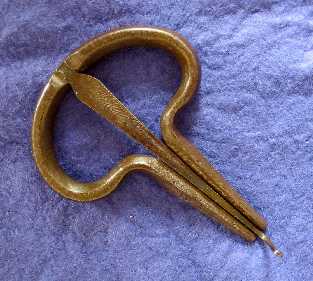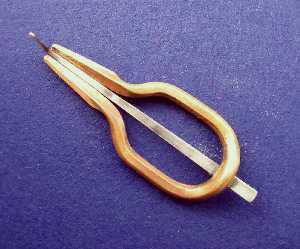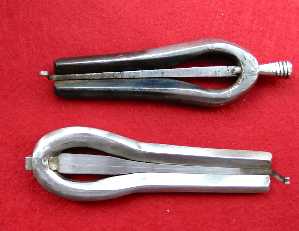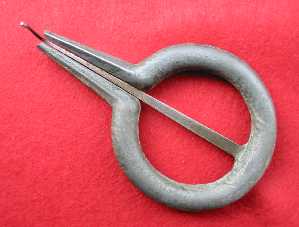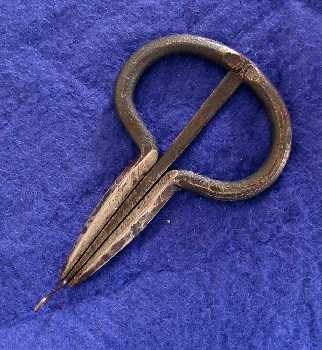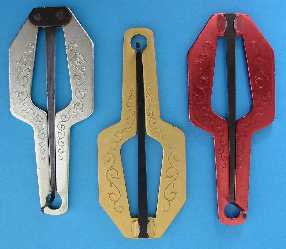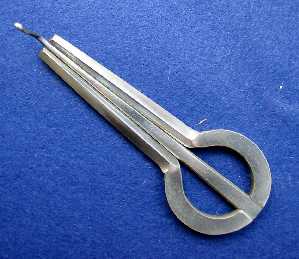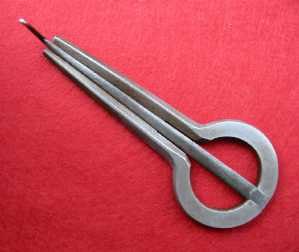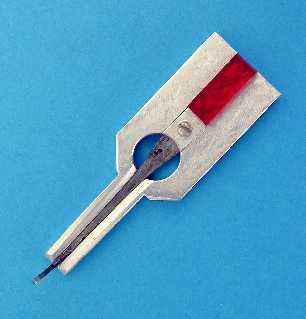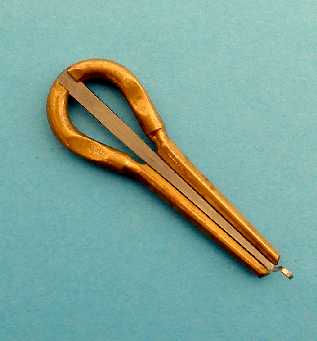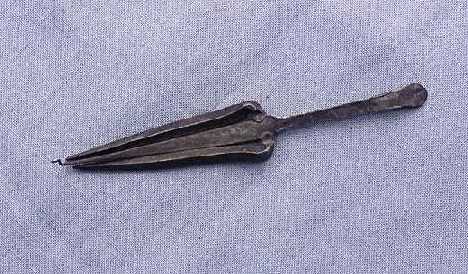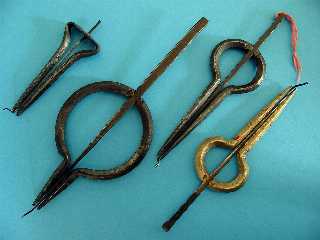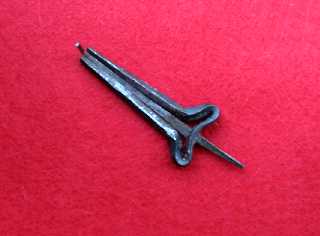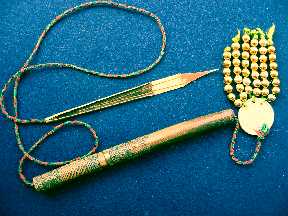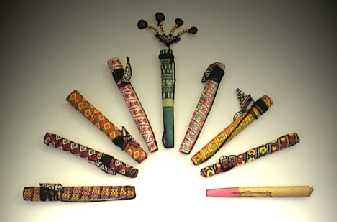...about
62 Jew's harp-types from all over the world in colored photographs - classified
on the vernacular names for the Jew's harps and on several Jew's harp-makers
|
|
|
|
|
|
|
|
|
Maultrommel
of Roland Bades, here a musical instrument tuned in B (photo: Izz van Elk) |
|
|
|
Roland Bades is the proficient pupil of
Franz Wimmer in Molln. A few years ago he assisted his master Wimmer in large-scale
production. Beside this Roland Bades also specialized in the same Austrian
traditional type on a higher technical level of quality. It seems to me, that
Bades has looked back at the historical times of the Jew's harp center that
Molln once was in Europe. |
|
only as a toy, but as a musical instrument.
His Jew's harps undergo an individual finishing off, they will be forged into
different sizes and, moreover, they will be tuned in the keys of a chromatic
scale. The high tuned Jew's harps, as A, A-sharp/B-flat & B [in German:
A, B and H] absolutely have my preference. It's a good Jew's harp in a
traditional design for a medium price, and. for those people who are very
serious about Jew's harp playing. |
|
|
|
|
|
Set of two Jew's harps, fixed to each other
|
|
|
Maultrommelwechsel |
|
|
Two
Jew's harps in ňne set will be used for changing the harmony in a song. In Bavaria,
South-Germany and in Austria the Jew's harp is placed in this way in folk-
and classical music. In general the distance between the two is a fourth or a
fifth.Trained players carry one set in each hand, so they can change key on
totally four Jew's harps. On both hands the middle finger will pluck the
instrument's reed. The first Jew's harp than is for tonica, the second for
dominant, third is for subdominant and the fourth for a key according to the
other three Jew's harps. On the photograph we see two Maultrommeln
made by Roland Bades connected to each other in the interval of a minor
second (B-H). |
|
|
|
|
|
Franz Bernögger's Maultrommel-type,
manufactured before the nineteen-eighties (photo: Izz van Elk). |
|
|
|
|
|
One of Jofen's initial attempts getting a real, |
|
|
|
|
|
|
|
|
Eichel
is the name of an old Maultrommel- type with a shamrock
design from the village Molln in Upper-Austria. The name has been originated
as one of the official names in the Memorandum of Association of the Mollner
Jew's harp Makers Guild. The Memorandum initially has been redacted by Count
Lamberg, Lord of the Steyr-Dominion, in the days of 1679. |
|
Bernögger,
Hörzing, Wimmer and (see photo Eichel) Schwarz. |
|
|
|
|
Norway |
Knut Tveit |
|
|
|
||
|
A very sympathical munnharpe from the
|
|
Jew's harp |
England |
Philipps-Crawshaw Harp Co. |
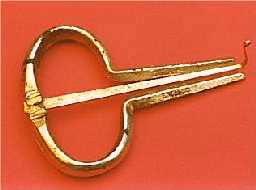
Large,
goldcoated Jew's harp of the Philipps-Crawshaw Harp Company,
England (photo: Jaap Flohil)
[Review is
absent - we only have one specimen]
|
U.S.A. |
Smith Brothers |
|
|
Two brothers active between 1920 and 1965. I just tested one specimen of them: a heavy piece of metal, with a dominant drone on its harmonics ["J.R. Smith" is written on the frame]. A pity that the harmonics won't come out. The Smith brothers started out making cast-iron trumps in the English style. But they switched around 1940 producing them in a more or less current Mollner manner, using square cross section steel. Several specialists on Jew's harp has ensured me that these Smith-Jew's harps were excellent handwork and the best to play on in those days. I believe their words, not so very much the one I have tested. But I like this dark-brown buzzer in my collection. At present they are still available in America, for high prices, considered as antiquities. |
||
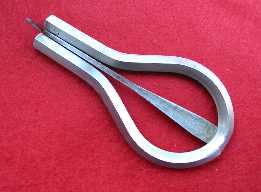
Freds Whitlow's Jew's harp
from USA (photo: Izz van Elk)
[Review is absent - we only have one specimen]

(photo: Izz van Elk)
There are no references at all on this
robust
Jew's harp from the U.S.A.
[Review is absent - we only
have one specimen]

|
▲ Jewsaphone is the curiosity manufactured by the American
artist and craftsman Clayton Bailey. As it is shown, it is a combination of a
Jew's harp with the bell of a trumpet. The trumpet amplifies the sound of the
Jew's harp without use of electricity, and gives the instrument a unique
sound. It is played by placing it lightly against the lips. The Jew's harp
can be removed from the bell, and played separately, and is held in place by
a small spring. - During the 1930-ies Jewsaphones also have been manufactured
in the USA by the company A.P.& M.
|
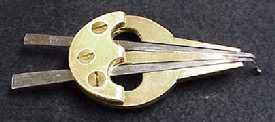
|
A frame made of bell-bronze in this design called If it seems that several American
Jew's harp-makers more or less have worked out their craft on Jew's
harp-manufacturing in an unsufficient way, then we'll find the opposite in
the results of Kendall Rownd, a American maker who lives in Holland. The
investigations made by this elaborate electronic engineer into the micro-mechanical
organology of the Jew's harp are spread over a period more than 25 years. And
that is why he could bring into the outside world of the 90's a top quality
for the Jew's harp. In the beginning the construction of his Jew's harps were
concentrated for powerful intonated staccato's, struck for- and backwards by
the thumb. |
|
Zeeland (Netherlands) |
Peter Kersten |
|
|
In cultural history Jew's Harps were
made of all kinds of material. Beside materials like bones and (bamboo)wood,
the metals dominate the principle of the Jew's harp in Europe, the New World
and Central Asia. One of the main approaches to the manufacture of Jew's
harps consists of the recycle of metals. In Holland it was Peter Kersten who
intensified himself in repairing Jew's harps with defection. His
concentration on re-making led him to create Jew's harps out of recycled
materials. In the meantime he has manufactured several Jew's harps out of
stainless steel, reinforcing- and driving-shaft steel. He applied also the
steel of lawn rakes and the various metals of saw-blades, spatulas (for
baking), doubled-ended spanners and feeler-blades. In his initial days in the beginning 90-ies, I played a while on a magnificient specimen bent out of a stair-rod, but I certainly played too wild in those days. At present Peter Kersten just works for the home-needs of the members of the Kwintes Ensemble, to whom he is connected as musician. At the whole his Jew's harps - they almost never are loud - contain reasonable sounds of harmonics. One day he may climb up to a top and then will make top quality. |
||
|
mondharp |
Zuid-Holland (Netherlands) |
Ger Groothedde |
|
... was during the late 60's absolutely the pioneer of Jew's harp making in Holland. Inspired by the meetings of (mor)čang-players in Afghanistan and India, he started the work on his very own. He hasn't made a lot, but they were all of a very good till excellent quality. Nowadays he doesn't forge them anymore, because the work is too intensive. Anyway, it is one of my personal wishes to have a Groothedde-mondharp in my concert collection one day. |
|
troempe |
Zeeland (Netherlands) |
Archaeological find |
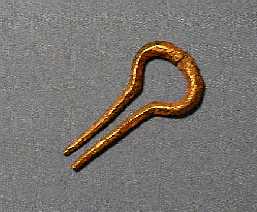
A
fifteenth-century Jew's harp found in an excavation at
the fortress Keyzershoofd at the shore of the river
Westerschelde, Zeeland (Netherlands). The lamel has
disappeared completely. The specimen is just
in size (photo: Izz van Elk)
|
Sicily (Italy) |
maker unknown |
|
|
Marranzanu or ngannalarunni is the type of Jew's harp on the island
Sicily. This large specimen has its frame of a cast metal. This very robust type of Jew's harp is very commonly in use among vernacular musicians on this island. The instrument is a real smith's craftwork, and it seems to me that the number of musicians who forge the finer type of Jew's harp for themselves, is very low. The marranzanu will probably always hold a main reputation as rhythmic instrument. Tiny marranzanu-specimens, with frames of cast metals, taught me to bring about very bright harmonics. But they are hard to find among the larger, robuster types. |
||
|
sa trunfa |
Sardinia (Italy) |
Maker unknown |
|
Quite fragile is the lamella of this trunfa from the island
Sardinia. Name maker is not known (photo: Izz van Elk)
|
||
|
Italy |
Andrea Bugari & Son |
|
|
|
||
|
Yakutia (Siberia) |
Ivan Christophorov |
|
|
хомyc |
Саха (Сибирск) |
Христофоров Иван |
|
One of the most impressive khomus-types from the Of all comtemporary Jew's harp
makers in the Siberian Sakha Respublika (Republic of Yakutia), Ivan
Christophorov rightly has been regarded as the top in making Jew's harps. And
he is! His Jew's harps (khomus) are made out of a very strong,
precious steel and iron, that will not oxidate. The oblong robust Jew's harps
all have a fixed O-design that forms the base of the frame. His khomuses
are polished and have received a very fine finishing touch. |
||
|
Yakutia (Siberia) |
Pavel Nikolajevitch Mikhailov |
|
|
хомyc |
Саха (Сибирск) |
Михайлов Павел Николайевич |
|
|
|
Yakutia (Siberia) |
Alexander Jacoblevitch Prokopiev |
|
|
хомyc |
Саха (Сибирск) |
Прокопйэв Александьр Якоблевич |
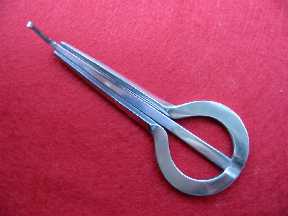
Traditional
Jew's harp-design of the Yakut, made
by Alexander Jacoblevitch Prokopiev (photo: Izz van Elk)
[Review is absent - we
only have one specimen]
|
khomus |
Yakutia (Siberia) |
Jegor Petrovitch Gogolev |
|
Хомyc |
Саха (Сибирск) |
Гоголев Егор Петрович |
|
Yakutian design from master maker Jegor Petrovitch Gogolev
(1924-1994) from the town Vilyuisk (photo: Izz van Elk) He has been a khomus-maker in the old tradition, that's to say, he worked on the flow from shamanistic ritualism. In this obsolete tradition the Jew's harp-forgers were aimed to have the heavenly powers from a burning fire into their "iron-strings". Heavenly powers that could make the Jew's harp to a divination instrument. Jegor P. Gogolev (I've heard that there are also another few Yakut khomus-maker calling Gogolev) has been praised for his craft in steel and iron all his life, but in my opinion not every khomus out of his hands had the quality of a masterpiece. But I have to be careful: I only played on two specimens of him. Myself, I am an owner of one good Gogolev-khomus. I was also in the opportunity to try out a second Jegor P. Gogolev specimen, but this one was really of a less quality. |
||

thin khomus with
carved ornaments on the eye,
manufactured by Gogolev (mladshij - junior), Yakutia
(photo: Izz van Elk)
[Review is absent - we only have one
specimen]
|
khomus |
Yakutia (Siberia) |
Revoriem Chemchoev |
|
xомyc |
Саха (Сибирск) |
Чемчоев Реворием |
|
A Siberian khomus from the maker Revoriem Chemchoev. Likewise an honoured Jew's harp maker from the Russian republic of Yakutia. His Jew's harps are oblong, as in the Yakut tradition. They contain on top of the circular base a sheet of steel with an ornamented engraving. The khomuses made by this very shy man, are very loud, which seems to injure the depth of the tone and its harmonics. Oxidation is (as far as I could judge) very strong on the lamellas and the inside angle of the embouchure-fork of the Jew's harp. The harmonic range is quite well present in the drone, but (unfortunetly) the sound can be interpreted as too sharp and also a bit too tinny. Some people praise these khomuses, personally, I will keep them somewhere in the middle. |
||
|
Bashkiria |
Robert Zagretdinov |
|
|
кубыз |
Башкирск |
Загретдинов Роберт |
|
The Jew's harps (kubys) of
Robert Zagretdinov are originated from several undoubtly self-designed
concepts. This man from the Bashkirian capital city Ufa is an experimenter on
Jew's harps in an enthusiastic sense. He made himself an electronic Jew's
harp that doesn't need the attack no longer from a playing hand. He
originated Jew's harps for children (see photo above), and he made
himself a set of 13 Jew's harps tuned in a chromatic scale. An
admirable design is his Grusha-Jew's harp, a pear-form wooden case
that is constructed around the frame of a metal Jew's harp. The player can
make an extra (pitching-up) sound effect by touching his finger (or his
thumb) on a hole in this wooden case. Conspicuous is that this man is a designer of forms in which a Jew's harp can be presented. This does not mean that his Jew's harps are elaborated as musical instrument in a fine way. Sometimes far from that. Zagretdinov is not a forger or a specialist for the micro-sounds of the Jew's harp. The quality of his Jew's harps as sounding objects, is very often mediocre, sometimes even going down to an inferior level. He deserves my respect as a performer designing all his own instruments. |
||
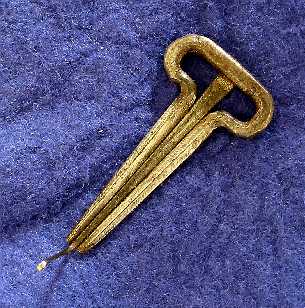
(foto: Izz van Elk)
[Review is absent - we only have one
specimen]
|
drymba |
Vasyl Shatruk |
|
|
дрымба |
Украйинск |
Шатрук Васил |
|
A tiny and fine singing drymba Drymba is the name
of the vernacular Jew's harp of the Hutsul-population living in the
Hutsulshchyna area of Ukrain and Rumania. Béla Bartók wrote in 1935 about the
instrument in relation to the semi-liturgical customs on the Easter-days of
the Hutsul in the border area of Rumania. This drymba made by Vasyl
Shatruk is a very tiny, vulnerable instrument, which should be played
by slight hands and fingers. Of most specimens the sound is very fascinating
because of the bright clear harmonics that are very good to hear. |
||
|
Altai (South-Central Siberia) |
Vladimir Potkin |
|
|
kомус |
(Горно) Алтай |
Поткин Владимир |
|
Vladimir Potkin is a Jew's harp
smith from the area of Gorno-Altajsk in Southern-Central Siberia, who
produces on all points very fine specimens of komuses. His Jew's harps
belong to the best selection of Jew's harps that ever were in the former Antropodium-store.
For years I have been satisfied with the tiny Potkin-komuses. For that
reason Antropodium has sold them, and they were sold the most too. They were
made in different qualities, but all in one steady design to behold.
[Antropodium chose this design for the link-clicks in this website] |
||
|
India has a rich tradition for Jew's
harps. In the north of India they play on the morchang, in the south
they play on the morsing, and obvious the latter is more practiced in
Indian music. Morsings and morchangs will be forged in
different qualities and sizes (in the review below I will mention the varied adivasi-specimens).
In general they will show a strong workmanship and will be forged in a
typical Indian way: (relatively) soft metal for the lamellas opposite to a
(relatively) hard metal for the frame. The morsing (and also the morchang) will have a very high-pitched sound, which is also characteristic of instruments belonging to the tradition of the tala, the directives for rhythms and metrics of the classical Indian music. They often have a rich harmonic range, but not too sharp. A robust, sometimes oxidation-prone Jew's harp, a bit rough to see and to feel in the hand. In general: unpolished frames. Not the easiest instrument for western and European hands, I think. |
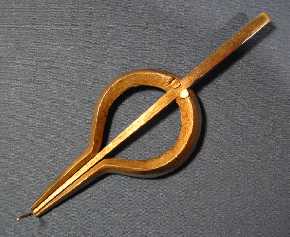
A morsing
from Maharashtra in India (photo: Izz van Elk)
|
A rather stiff but shining morsing from the area near the Indian city of Poona in Maharashtra. |
|
Afghanistan |
Uzbek-population |
|
|
Uzbek-čang from Afghanistan shows a tapering fork-shape of the
frame and not, In the continental area between the Middle-East and the Indian peninsula, metal types of Jew's harps are generally the vogue among the numerous (semi)-nomadic populations. There certainly is an essential difference between the robust morchang- and morsing-types of India (seen in the previous review), and the thin Jew's harps forged by the hands of Uzbek-people of Afghanistan, as shown here above. This čang-type was a very common mouth-instrument among the European travelers who went to the Near East during the sixties and seventies of the previous century. Tiny and not unfriendly in their "speech". Specimens of it were in circulation in Holland and easy to purchase.... then! Now they are rareties to find, and kept as a real collectors' item. |
||
|
Afghanistan, Nepal, Rajasthan |
semi-nomadic populations, Jajmani-casts, Indian adivasi |
|
|
from left to right: Jew's harps from Nepal, Afghanistan In the continental area between the
Middle-East and the Indian peninsula, metal types of Jew's harps are
generally the vogue among the numerous (semi-)nomadic populations. There
certainly is an essential difference between the robust morchang- and morsing-types
of India (seen in the previous review), and the thin, sometimes defective
Jew's harps that are forged by the hands of nomadic people, the casts of
Jajmani-musicians in Rajasthan and several adivasi-populations in
India. The latter even more carve wooden Jew's harps. The lamellas of these types, sometimes as thin as long strong needles, are reminiscent of obsolete manufactures of thin Jew's harps of tough wood. Yes, in these types the acculturation between the wood and the iron can be perceived. Sometimes the two parallel extremes of the fork diverge so much, that it causes almost the absence of an audible tone. Anyway, it is nice to have such a specimen in your collection, and a lot of collectors would like to have it. |
||

A chang originated by
the Peshawar-peoplefrom Pakistan. The frame
is casted from brass, and ornamented with red-pink
spots and cross-motifs (photo: Izz van Elk)
|
machinga |
Nepal |
Sunawar-population |
|
Fine forge work can be found in this striking machinga from the Sunawars,
Nepal. Size of the frame is You'll discover how subtle hands
must be if you play a machinga from the Sunawar. You need very small
hands to handle this miniature Jew's harp. Among the Tamang-people in the east
part of Nepal one will find a same miniature type under the vernacular name gon-kap.
|
||
|
A miracle of sounds is this idioglot brass Jew's harp I never saw so many people, asking me
for this very special Jew's harp from South-East Asia. It must be a goldmine
if you have them to offer now in Europe. And its already a pitty, because the
ncaas will be sold for 15-30 euro's or dollars, while you may find
them for a few pennies near the source in the streets of Vietnamese towns, in
the hands of people who have had a hard labour on their production. And that
is how it goes. Đan môi's from the Vietnamese Hmong-population packed up
into their bamboo-cases with decorations. The decorations consist of beads,
twisted woolthreads, ornamented bandages of textile, colourpaints and even
vernacular coins.
The sound is long and sharp. You
don't have to put it at your teeth, just to the lips. It will sing in all
directions. No, it's not a good Jew's harp for fast rock 'n roll rhythms. But
it will refer you to its mytho-animistic background reputation as an
audio-enticer of nature-spirits. You soon will understand. |
|
For a reaction, a
question, a noteworthy fault, |

